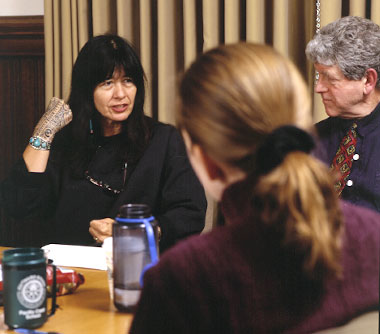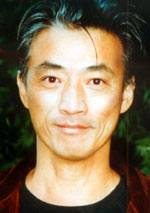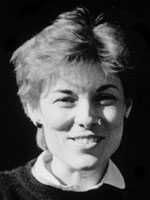Inspiring Us to Write: 25 Years of the Vassar Writer-in-Residence Program
Every February brightens when Vassar’s new writer in residence comes to campus. This year American Indian poet Joy Harjo arrived in snowy February from her home in Honolulu. “The weather’s different here,” she observed. Like visiting writers before her, Harjo gave public readings, visited a range of classes, and worked individually with students writing theses in poetry or fiction. This year, though, was special. In her culminating public appearance, Harjo played saxophone and performed poems with her band to help celebrate 25 years of the Vassar Writer-in-Residence Program.

The practice of bringing a fiction writer or poet to campus for an extended residency began in February 1979, when the Department of English lecture committee, composed of Eamon Grennan, Susan McCloskey, Patricia Wallace, and Frank Bergon, obtained a matching grant from the National Endowment for the Arts to initiate the program with the double residency of American Indian novelist Leslie Silko and award-winning poet Philip Levine. In the quarter century since, Vassar has sustained the program with a remarkable array of fiction writers and poets from all over the United States as well as England, Ireland, and Australia.
“When I think about it,” Vassar Professor of English and novelist Paul Russell said, “I’m particularly impressed by the diverse group of writers we’ve brought to campus — not only in terms of race, ethnicity, and sexual orientation, but also in terms of sheer style, both on the page and off. The writer-in-residence program has given students — and faculty — a remarkable opportunity to work with many of the most important poets and fiction writers of our time.”
The special character of the program is that it goes beyond a single lecture or reading by a literary star. In class visits and individual conferences, students talk to writers about the work beyond the page, probe stylistic practices and concerns, and in turn receive valuable advice about their own writing. As Patricia Wallace said, “The residency has been a way to demonstrate how central the creative artist is to our vision of the study of literature. It has also allowed some of our students to work mano con mano with some of the best writers alive.”
A working encounter with an established writer can be formative for an aspiring student. Karin Cook ’90, author of the novel What Girls Learn (Vintage Books, 1997), vividly recalls her initial meeting with novelist Howard Norman and poet Jane Shore during their dual residency in February of her senior year. “I can still hear their voices,” she said. “It was a first for me — a chance to reconcile the page with the person. And these encounters offered the kind of mentoring one dreams of: writers talking about their creative process, sharing their wisdom and missteps, and giving advice about graduate school and publication. There was always so much anticipation and excitement in the room. Meeting in groups and one-on-one with the writers in residence who came through Vassar made me believe it was possible to be a writer.”
February is an ideal time for having the writers on campus because senior English majors are in the midst of writing creative theses in conjunction with the yearlong seminar “Senior Composition.” These students discuss their writing with a visiting writer after a full semester of working with a Vassar instructor but with enough time left for revision before their theses are due at the start of spring break.
Two graduates of “Senior Composition” who have returned to Vassar as writers in residence are Elizabeth Spires ’74 and David Wong Louie ’77. “Coming back to Vassar in 1987 as a writer in residence,” Spires recalled, “I was struck at how focused and articulate the students in ‘Senior Composition’ were. And how talented. I suppose, being an alum (in my 30s, then!) I was seen as a role model. Just as, in a more distant, ‘mythic’ way, Elizabeth Bishop ’34 was a role model for me.”
Professor Emeritus of English William Gifford remembers the return of his former student-turned-poet Elizabeth Spires to his classroom and “the gentle intensity with which she talked to a good poet in ‘Senior Comp’ about a poem set in a German city. ‘You’re not writing a biography of the town,’ she explained — it was a poem about the writer.” And he remembers David Wong Louie talking to a class of writing students and “brooding about how he got into a sort of dreamy connection with his creative consciousness by keeping a typewriter on his bed and starting to write when he began to wake up — before the censors kicked in.”
Such advice — often individualistic, sometimes quirky, frequently inspiring — has also included poet Olga Broumas’ breathing and body-consciousness exercises to help students center themselves physically before picking up the pen or mouse; fiction writer James Salter’s instructions for the perfect 1950s Air Force officer’s martini; Chicano poet Alberto R�os’ elegant lecture on the evolution of the alphabet as necessary knowledge for every aspiring writer; and Filipina-American novelist Jessica Hagedorn’s personal need for a manual typewriter to earn her revisions letter by letter rather than with the broad cut-and-paste commands of a computer.

Students also see the mishaps and foibles writers share with them in the human effort of getting through the day. In the early years of the program, before writers in residence were housed on campus in comfortable Pratt House, they lived where housing could be found. Poet Philip Levine found himself in an apartment above a beauty parlor on Collegeview Avenue, his morning writing invaded to his annoyance by the chemical fumes of permanents. Vassar Professor Nancy Willard recalled that when Stanley Kunitz, who later became the U. S. poet laureate, arrived at the empty house of a faculty member on sabbatical, he promptly began to carry out the list of tasks left on the kitchen table for the housecleaner. Even after the move to Pratt House and the care of Kathy Brown in the Dean of the Faculty Office, the eminence of a visiting writer was not always immediately appreciated. A woman from Vassar Buildings and Grounds reported novelist Madison Smartt Bell to authorities in Main House as a “suspicious person” because he had answered the door sweating and disheveled. He had been in the middle of a brown-belt Tae Kwon Do workout in the living room when the doorbell rang.
The numerous honors earned by writers — Pulitzer Prizes, National Book Awards, MacArthur Fellowships — often arrived after a Vassar residency. Some writers visited campus early in their career, or as a favor to a faculty member, but always for a modest honorarium from the steady though limited resource of the M. A. P. Smith Fund. To compensate for the lack of increased funding over the years, the residency gradually shrank from a month to two weeks. Beginning in 2002, a generous gift from an anonymous donor allowed renewed expansion of the program and long-range planning. As a result, Jhumpa Lahiri, Pulitzer Prize-winner for her stories about Indian American life, and Dagoberto Gilb, winner of the PEN-Hemingway Award for his fiction about Chicano experience in the West, are in place as writers in residence for February 2004 and February 2005.
Besides writing courses, the writer in residence visits other classes in the English Department and beyond. This year, Joy Harjo visited classes in post-colonial literature, 20th-century literature, and Native American literature. She met with students in both the American Culture Program and Environmental Studies Program and extended her residency into the Poughkeepsie community with a voluntary visit to Dutchess Community College. After her conversation with students in “Terrain: Geographical and Literary Perspectives on Landscape,” H. Daniel Peck, director of Environmental Studies, commented, “Joy was fantastic in our class, truly a ‘joy.’ The students were so moved. She brought landscape, and the idea of landscape, alive for them, with eloquence and quiet passion. They’ll never forget it. It’s really what Vassar is about, this kind of remarkable opportunity.”
On the first day of March, Joy Harjo flew back to balmy Honolulu. A week later, Vassar writing students submitted their completed senior theses. Spring break began.
— Frank Bergon
Frank Bergon, novelist and professor of English, directed the first Vassar Writer-in-Residence Program.
Photo credits: Joy Harjo: Will Faller; David Wong Louie: Jacklyn Louie; Elizabeth Spires: Dixie Sheridan

I was honored by the invitation to return to Vassar as its writer in residence. Just look at the impressive list of writers who have been part of the program, writers of literary renown. For me, it was a milestone of sorts. The writer-in-residence program didn’t exist when I was an undergraduate. But many writers came to campus and gave readings from their work. Seeing the writers in person was a revelation — there were actual people behind the words on the page. The writer in residence brings this experience even closer to the students: for a few weeks students have ready access to a living, breathing author, one whose sole purpose on campus is to be available to talk writing and read and discuss student work.
When I returned as writer in residence, I was enormously impressed by the students I met in Frank Bergon’s “Senior Comp” and by the quality of their work. The stories I saw were uniformly excellent. In their knowledge of writing and their commitment to the craft of writing, the students felt more like a group of writers than a bunch of students in a writing class.

The writing program at Vassar is, in many ways, unique, because there has always been an intense emphasis for English majors on the literature component of the major. It just isn’t possible to be a writer at Vassar without taking a lot of literature classes. I can’t think of anything more important for a young writer than this immersion in reading, this developing awareness of a literary tradition.
The writer in residence is a kind of bridge to the outside literary world that young writers at Vassar are poised to enter. Young unpublished writers want to be read. They want a reaction. As writer in residence, I tried to give the students the kind of thoughtful critique and written annotations that my own writing teachers at Vassar, William Gifford and Judith Kroll, had given me. Vassar taught me that what’s most important in teaching writing is the human element — not a piece of technical advice on “craft,” though that can be useful — but an interest in the student as a human being who has lived (or imagined) a life worth writing about.
Vassar Writers in Residence, 1979–2005
1979: Philip Levine and Leslie Marmon Silko
1980: Jayne Anne Phillips
1981: Stanley Kunitz
1982: —
1983: Hilma Wolitzer
1984: Carolyn Forche
1985: William Trevor
1986: James Salter
1987: Elizabeth Spires ’74
1988: Ellen Currie
1989: Olga Broumas
1990: Howard Norman and Jane Shore
1991: Leslie Norris
1992: Alberto Rios
1993: Katha Pollit
1994: Peter Carey
1995: David Wong Louie ’77
1996: Madison Smartt Bell
1997: Jessica Hagedorn
1998: Jim Shepard
1999: Lorna Dee Cervantes
2000: Louis Owens
2001: Christopher Bram
2002: John Balaban
2003: Joy Harjo
2004: Jhumpa Lahiri
2005: Dagoberto Gilb
